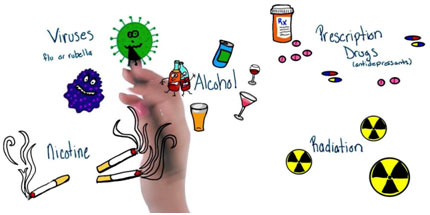Teratogen
Any type of agent or factor that can create congenital defects, or boost the possibility of congenital problems occurring.
Teratogenesis
The process whereby congenital malformations are generated in an embryo or fetus.
Teratology:
Teratology is the study that examines the causes, mechanisms, and patterns of irregular development.
Mechanism of Teratogenesis
The Mechanism of Teratogenesis fall under broad categories based on the etiology of congenital malformations:
- Errors in genetic programs based upon variances in the genotypes of the embryo or the reduced likelihood for the mistake of the regular genotype;
- Environmental agents or factors that connect with an embryo during the period of development (medications, chemicals, radiation, hyperthermia, infections, irregular maternal metabolic states, or mechanical factors).
- The etiology of human malformations consists of both hereditary and environmental aspects.
Six Mechanisms of Teratogenesis
A great deal of teratogens and also damaging developmental results make it hard to identify unifying systems. 6 principal teratogenic mechanisms based on organizations of significant abnormality with medications made use of by females of reproductive age:
- Folate antagonism
- Neural crest cell disruption
- Endocrine disruption
- Oxidative stress
- Vascular interruption
- Specific receptor- or enzyme-mediated teratogenesis
Folate Antagonism
Folate, the generic term for a water-soluble B vitamin, takes place in high amounts in certain natural food (fruits, leafy vegetables, beans, and liver) as polyglutamate. The synthetic form, folic acid (a monoglutamic acid) is also used. It functions as an essential co-enzyme in numerous biochemical reactions like purine as well as pyrimidine synthesis as well as DNA methylation reactions.
Several drugs disrupt the folate metabolism as well as have teratogenic impacts with the restraint of the folate methylation cycle. Two basic groups of drugs act as folate antagonists. The first group contains a competitive inhibitor of DHFR which obstructs the conversion of folate.
The 2nd group of drugs might antagonize other enzymes in the folate metabolism. Disruption in the folate metabolic rate plays an essential function in the root cause of heart, rectal atresia, and urinary system tract abnormalities.
Neural Crest Cell Interruption
The neural crest is an important, pluripotent cell populace that originates in the neural folds. The neural crest can be separated into two major populations: the cranial and also truncal neural cells.
Different cell kinds and frameworks including cartilage, nerves, and also muscle mass is derived from the cranial neural crest. The truncal neural crest creates essential parts of the peripheral nervous system. The cardiac neural crest is sub-population of the cranial neural crest.
Neural crest-related cardio malformations consist of aortic arch abnormalities and so on. Appropriate induction, migration, expansion, as well as the distinction of neural crest cells, are snugly managed with a variety of molecular signals and receptors implicated in neural crest development.
So, medicines that disrupt these molecular pathways may generate neural crest malformations. For instance, retinoic acid is an essential signaling molecule in neural crest development. Thus, excess, as well as a shortage of retinoic acid, seems to trigger neural crest-relevant malformations.
Endocrine Disturbance: Sex hormones
A number of medicines have been developed to mimic or inhibit the actions of hormones. These drugs and also endocrine-disrupting chemicals (EDCs) might interfere with the physiologic feature of endogenous hormones by affecting their release, binding or metabolic process.
The activities of EDCs in utero have actually been of concern because of their possible influence on the developing reproductive system, particularly considering that therapy of expecting females with the synthetic estrogen DES led to a boosted risk of vaginal adenocarcinoma in their daughters.
Besides this, prenatal direct exposure to DES has also been being much more at risk to endocrine disturbance than female development as a result of its hormone dependence.
Oxidative Stress
In vivo, several medications, referred to as redox cycling agents used in the therapy of epilepsy, heart arrhythmias, and also cancer cells, undergoes single-electron reduction reactions producing extreme species.
In redox cycling reactions which entail oxygen reactive species (ROS) are created. The production of ROS is caused by internal as well as exterior agents. In the same manner, the generation of ROS can be lowered or turned around by different enzymes. ROS can additionally be hazardous by binding covalently or irreversibly to cellular macromolecules.
Oxidative stress, an inequality in between ROS generation as well as an antioxidant defense mechanism of a cell or cells, creates permanent oxidation of DNA, proteins, and also lipids causing inactivation of many enzymes and cell death. Oxidative stress might additionally affect genetic expression.
Throughout the prenatal period, this might result in abnormality and development retardation and in extreme cases in an in-utero fatality. Developing embryos are especially susceptible to high degrees of ROS as a result of their weak antioxidant defense, in particular in the early stages of organogenesis. Oxidative stress and anxiety associate with the following birth defect like limbs issues, neural tube flaws, taste, and also cardiovascular issues.
Vascular Disruption
Vascular disturbance defects are structural abnormalities resulting from interference with or extrinsic malfunction of an initially typical prenatal advancement of the arteries, blood vessels as well as veins.
A teratogen applies its impact on the fetus throughout the first three months of development. Prenatal exposure to factors that can generate vascular interruption, nonetheless, can likewise cause damages later in maternity to structures that were at first formed normally.
After birth, it might be impossible to establish whether a specific structural abnormality, such as a limb flaw, is the outcome of an abnormal developing procedure fundamentally or vascular disturbance.
All medications with vasoconstrictive or vasodilating results might have the possibility to cause birth defects because of vascular disturbance. An abnormality that was attributed to vascular disruption includes hydranencephaly, small intestine atresia.

